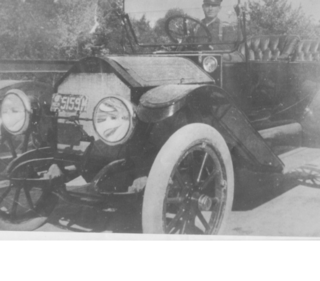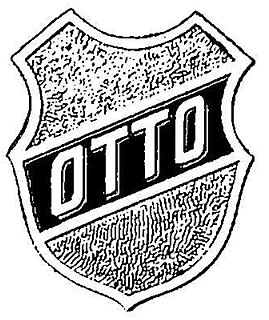
The Alpena Flyer was an American automobile manufactured between 1910 and 1914 in Alpena, Michigan by the Alpena Motor Car Company. Approximately 480 cars in 13 models were produced, costing around $1,500, and just one car is known to exist today. The car was intended to be light and inexpensive, and to make Alpena into an "Automobile City", although this latter goal failed.

Otto and Ottomobile were brass era automobile marques of the Otto Gas Engine Works of Philadelphia, Pennsylvania from 1910 to 1912.

Northern Manufacturing Company was a manufacturer of Brass Era automobiles in Detroit, Michigan, automobiles designed by Charles Brady King. Early advertising included catchy phrases such as "Utility is the Basis for Beauty" and "Built for Business" and the famous "Silent Northern".

St. Louis Motor Carriage Company was a manufacturer of automobiles at 1211–13 North Vandeventer Avenue in St. Louis, Missouri, founded by George Preston Dorris and John L. French in 1898, with French taking charge of marketing and Dorris heading engineering and production. St. Louis Motor Carriage was the first of many St. Louis automakers and produced automobiles from 1899 to 1907.

Templar was a manufacturer of automobiles in Lakewood, Ohio from 1917 to 1924. The company was named for the Knights Templar and used a Maltese Cross as an emblem.

The Lexington was an automobile manufactured in Connersville, Indiana, from 1910 to 1927. From the beginning, Lexingtons, like most other Indiana-built automobiles, were assembled cars, built with components from many different suppliers. The Thoroughbred Six and Minute Man Six were popular Lexington models.
F. B. Stearns and Company, later known as F.B. Stearns Company was an American manufacturer of luxury cars in Cleveland, Ohio marketed under the brand names Stearns from 1900 to 1911 then Stearns-Knight from 1911 until 1929.

The Westcott was an automobile produced in Richmond, Indiana and Springfield, Ohio in the United States between 1909 and 1925 by the Westcott Motor Car Company. The car company was named for its founder, John Westcott.

The Empire was an American automobile manufactured from 1910 until 1919. Marketed as "the little aristocrat", the Empire 20 was a four-cylinder shaft-driven runabout built in Indianapolis. The model "A" was a conventional runabout for three passengers with a rumble seat. The model "B" had two bucket seats, a longer hood and was geared higher to attain faster speeds.

Marquette was an American automobile manufacturer established by General Motors in 1909 after the purchase of the Rainier Motor Car Company. The Marquette Company did not last long and in 1912 GM announced the company would be closed.

The Matheson was a luxury American automobile manufactured from 1903 to 1912, first in Grand Rapids, Michigan, then Holyoke, Massachusetts and from 1906 in a purpose-built factory in Forty Fort, Wilkes-Barre, Pennsylvania.

The Metz Company was a pioneer brass era automobile maker established by Charles Herman Metz in Waltham, Massachusetts, from 1909 to 1922.

The Cole Motor Car Company was an early automobile maker based in Indianapolis, Indiana. Cole automobiles were built from 1908 until 1925. They were quality-built luxury cars. The make is a pioneer of the V-8 engine.

The Cunningham automobile was a pioneering American production automobile, one of the earliest vehicles in the advent of the automotive age. It was produced from 1896 to 1931 in Rochester, New York by James Cunningham, Son and Company.

The Flanders Automobile Company was a short-lived US-American automobile manufacturer which operated in Detroit, Michigan, from 1910 to 1913. Its only product was sold through Studebaker dealerships.

The Commonwealth Motors Corporation was a luxury auto company that produced cars from 1917 to 1922. The company was founded in Chicago as Partin-Palmer company in 1913, but in 1915 got into financial trouble. So, in 1917, the name was changed to Commonwealth, and production was moved to Joliet, Illinois.

The Packard Motor Car Company introduced their first four-cylinder engine in 1903 initially as a top level car along with the Packard Model F. It was their only automobile offered and exclusively used a four-cylinder engine from 1903 until 1912 and established Packard as a luxury car maker, and was replaced by the 1913 Packard Six.

The Buick 4 was a series of passenger cars produced by the Buick Division of GM from 1909 through 1918, and was available as a touring car, phaeton or roadster. It was available with the Buick Model B as a larger alternative offering a larger engine and better durability. It became the junior sedan in 1914 when the Buick Six was introduced.
The Series 22 Special was a four-seat passenger car produced by the Oldsmobile Division of GM in 1910 and 1911. It was the first car engineered by Oldsmobile after it became a division of GM and began sharing a platform with the Buick Model 10. It became the entry-level model for Oldsmobile, replacing the discontinued 1909 Model 20 and the 1909 Model D, while Oakland Motor Car Company became GM's entry level brand as Chevrolet didn't join GM until 1917.
The Oldsmobile Series 28, also known as the Autocrat, was a mid-level four seat passenger car produced by GM's Oldsmobile Division for 1911 and 1912. It was based on the top-level Oldsmobile Limited while using a four-cylinder engine, and was manufactured in Lansing, Michigan.

















